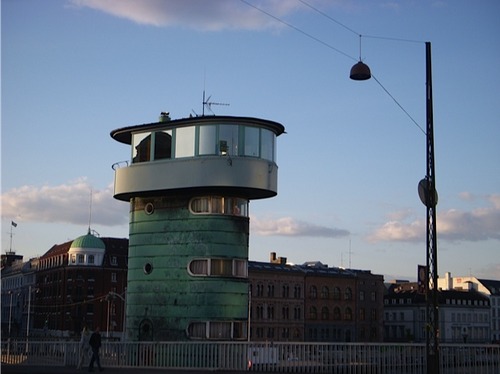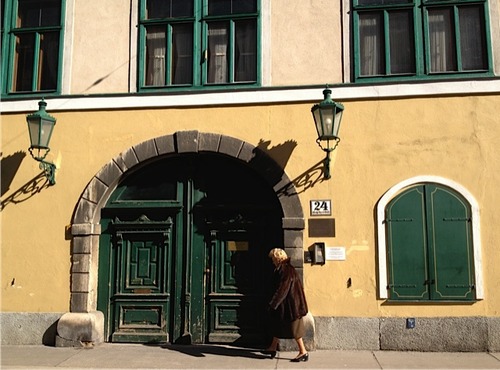
A Travelogue in Five Parts By Nicholas Kulish
Nicholas Kulish spent more than half a decade tracing the path of Aribert Heim, a Nazi concentration camp doctor who fled postwar justice in Germany. The research for his book on Heim, The Eternal Nazi, co-authored with Souad Mekhennet, led him to Denmark, Austria, Egypt, Morocco, and across Germany. This week on the Logger we’ll be posting five entries from his travels.
I. Copenhagen, Denmark
The rain was falling steadily on the eastern coast of Denmark, the kind of day when a wise traveler finds a warm nook and catches up on reading or finally visits whatever obscure museum sits within easy sprinting distance of the hotel. Instead I trudged through the northern Copenhagen suburb of Klampenborg, searching for a tiny restaurant tucked into a little yellow cottage. I had not come looking for the pungent local cheeses or the picturesque views of the Oresund. Nor was I there chasing the minor works of the famous Danish architect Gottlieb Bindesbøll, who built the elegantly unassuming little gatekeeper’s house facing the Øresund Strait.
I sought out Den Gule Cottage because almost forty years earlier a young German named Rüdiger Heim had quit his medical studies and his career on the men’s tennis satellite circuit and moved to Denmark to bus tables at a friend’s restaurant. It was menial work but also a much-needed refuge for a confused dropout. At the time he had recently traveled to Cairo, where he saw his father for the first time since he was a little boy. This difficult experience was further complicated by the fact that his father was a wanted Nazi concentration-camp doctor named Aribert Heim. I was working with a colleague on a book about both of them, in the midst of a five-year odyssey that took me to North Africa and tiny towns across Germany, not to mention this waypoint between Noma and Hamlet’s castle.
Since I was old enough to set out on my own I have been an avid traveler. I turned this obsession into a profession seven years ago when I became a foreign correspondent for The New York Times, a job that involves constant, restless motion. A journey to Vienna sticks out particularly in my mind for its brevity and simplicity. I flew there from Berlin for the express purpose of looking at a plane parked on the tarmac. The aircraft carried the Russian spies who inspired the show “The Americans,” brought to the city of “The Third Man” for a swap of undesirables. After scrutinizing the fuselage from the terminal, I took the airport train to the city and checked into the Le Méridien by the opera.
Over the course of my research into Heim I found that traveling for a book was distinctly different. Gone was the business hotel squatting as close to the foreign ministry as zoning would allow; with the expense account went the porcelain plates, replaced by crumpled paper bags; the taxis elongated into buses; and time stretched out as well, allowing for habit and repetition, the hallmarks of living versus passing through.

When I returned to Vienna for weeks of archival research a hotel was out of the question. Instead I took a short-term apartment rental on Grosse Schiffgasse, tucked away in Vienna’s 2nd District. I chose it because I could walk each morning across the Salztorbrücke over the Danube to the late, famous Nazi hunter Simon Wiesenthal’s old office. I had no idea when I arrived that I would find myself in a thriving Orthodox Jewish neighborhood. In the evenings I would eat cheap meals at the musty Café Sperlhof, amid the teetering stacks of old board games, not just Monopoly and Sorry but the Abenteuer im Weltall space game and Der Schatz im Silbersee, a Karl May Western adventure—complete with canoe-paddling Indians on the cover.
At the Austrian Interior Ministry I would knock off around midday for a lunch of spicy Fiakergulasch with egg and pickle with the Mauthausen Memorial archivists, a regular working Josef of Vienna, if only for a couple of weeks. After work I would jog slow loops around the Augarten, a baroque park, dominated not by the elegant old castle but by giant flak towers dating back to World War II. The concrete towers loomed over the greenery, like extras from a Lord of the Rings set wandering onto the Merchant Ivory lot. The Viennese hunting for spring ramps or walking with hiking poles in the middle of the city were oblivious to these hulks of history, inured over the years to the sight, as I was within a few days, settled into my place, finding the groove of routine.
See Part I. Part II, Part III, Part IV.
Photographs by Rachel B. Doyle
Nicholas Kulish is the East Africa correspondent for the New York Times. His latest book is The Eternal Nazi. Follow him @nkulish.




